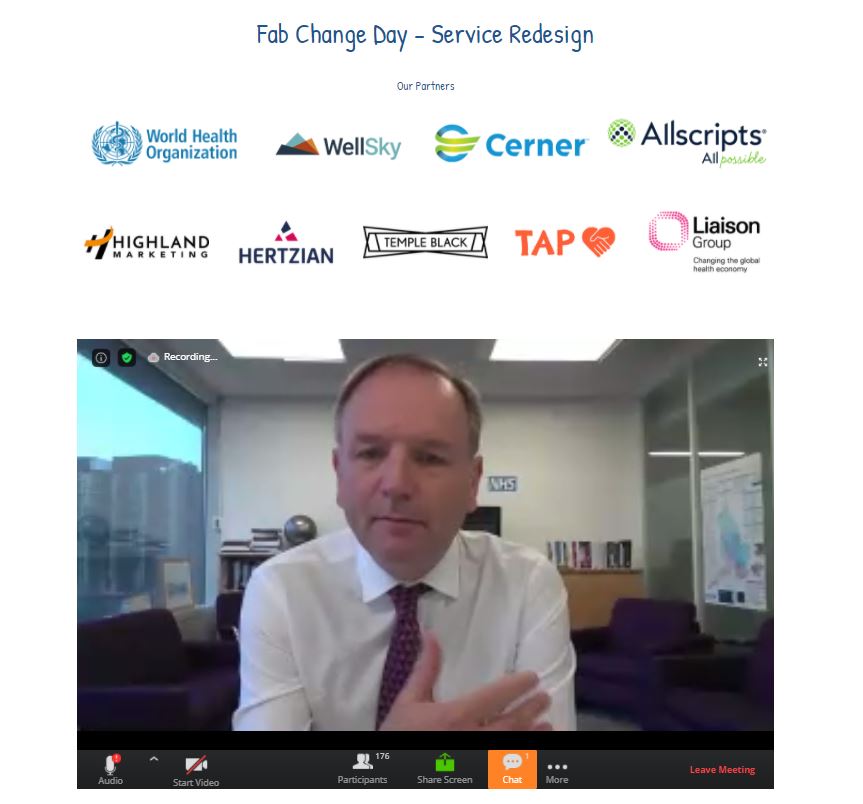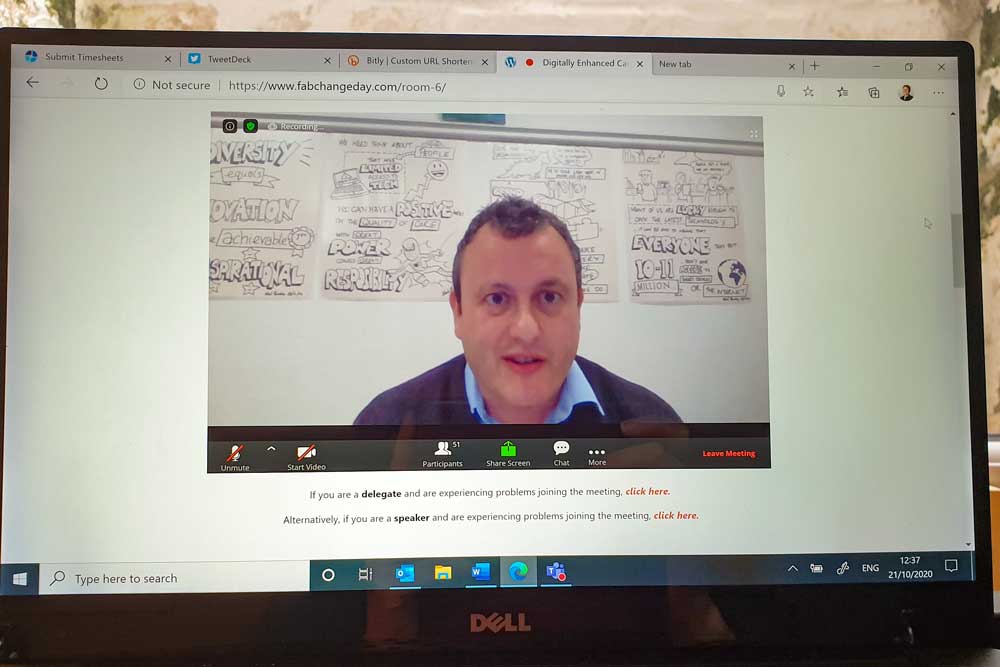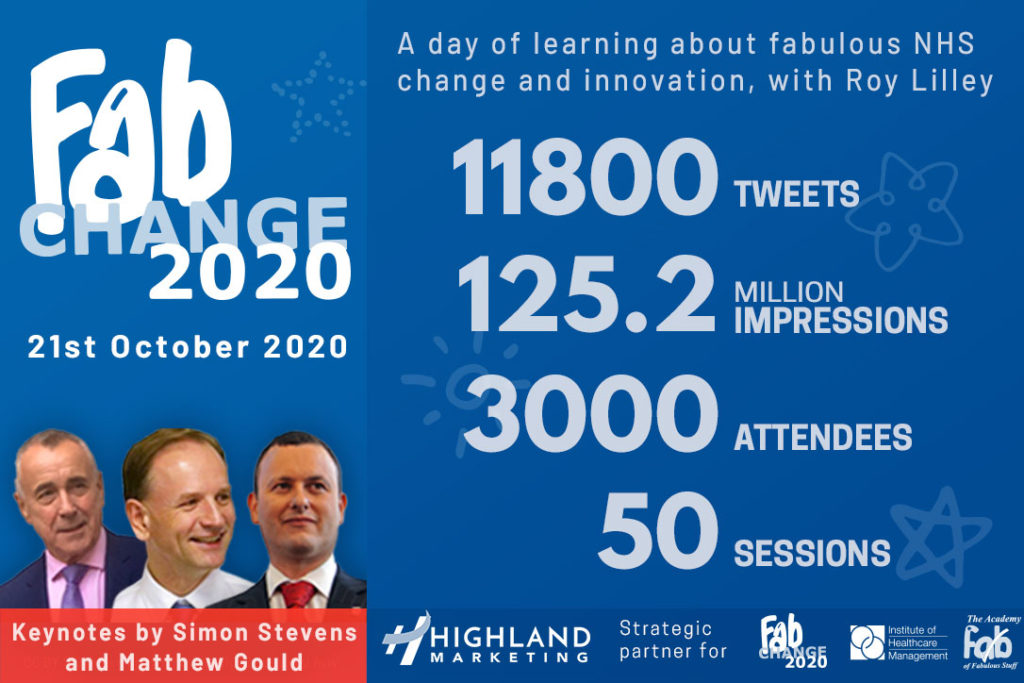The Academy of Fabulous Stuff took Fab Change Day online this year, and communications partner Highland Marketing was on hand to capture the highlights of an unmissable and moving event.
The Academy of Fabulous Stuff held the seventh Fab Change Day in late October. Because of the coronavirus emergency, all the sessions were online.
That didn’t stop NHS and health tech professionals dialling in from homes, offices and even cupboards to celebrate success, swap ideas, and offer support at the end of a hard but sometimes exhilarating six months.
Highland Marketing is the communications partner for the event, and Matthew D’Arcy and Lyn Whitfield listened in to the most unmissable sessions hour by hour. Our seven fabulous highlights:
1. Keynote with Sir Simon Stevens, chief executive of NHS England
The level of cancer treatment being delivered in the NHS is not just back to normal but has gone above normal, Sir Simon Stevens told the breakfast session of Fab Change Day.
“On cancer care, we have to make sure we are getting timely care for patients,” he told attendees, against a backdrop of concern about the impact of the novel coronavirus on the NHS, which stopped elective activity in the most acute phase of the first wave. “[The good news is] we are doing more cancer treatments now than we would do at this time of year.”
However, Sir Simon said the different levels of Covid-19 cases being seen across the country would mean that the NHS will need to be “locally agile in how we respond to changing needs – Covid and non-Covid – in the coming weeks.”

In a wide-ranging discussion with health commentator Roy Lilley, who leads the IHM and Academy of Fabulous Stuff, Sir Simon spoke about the need to better support NHS staff who have been under substantial stress. Two days before their discussion, NHS England announced a £15 million package to expand outreach work and improve access to mental health services as part of its commitment to do this.
Sir Simon also spoke about environmental priorities. “We, the NHS, are [responsible for] 4 or 5% of the carbon emissions for this country,” he told delegates. “If this country is going to play its part in becoming carbon net neutral then the NHS is going to have to play [its] part.”
An expert panel had reported on the practical steps that will be needed to make the NHS the world’s first national health system to become carbon net zero, he added, and the NHS England board had signed off on a multiyear plan to achieve this aim.
The NHS chief executive also commented on US president Donald Trump’s treatment for Covid-19. “We now know a lot more about how to treat patients. When Donald Trump got his cocktail of medicines, the ones proven to reduce your chance of dying were the ones that have been tested in the NHS.”
2. Digital health innovations: how Covid-19 has changed the future
In the first session in the ‘digitally enhanced care’ stream, senior nursing IT leaders discussed their trusts’ response to Covid-19 and how their Cerner electronic patient record and information sharing systems have supported it.
Tristan Kerr, divisional director of the medicine division at Barts Health NHS Trust, outlined how Whipps Cross Hospital went live with Cerner Millennium almost exactly a year ago. The hospital was planning a second wave of go-lives, including e-prescribing, in March “and then everything changed” as Covid arrived.
As it helped to set up the Nightingale Hospital at Excel London, the trust rethought its own outpatient activity. Kerr described how it bought webcams and moved to delivering 70% of its outpatient activity digitally, while also sharing more information with GPs.
Gordon Elder, associate director of nursing and chief nursing information officer at Newcastle Upon Tyne Hospitals NHS Foundation Trust, said it had also gone through a ‘big bang’ go-live a year ago, which he thought was “one of the hardest things I’ve ever done.”
Until, in March, he got a text from his chief executive asking if he would like to help to set up Nightingale North East, and found himself “standing in a warehouse, working out where to put beds.” Elder said the Nightingale learned from London that digital working was essential, because paper rapidly becomes contaminated.
In the end, it managed to have just three forms: and it only had one of those because the Nightingale’s ventilator supplier used Windows 3.1: so its devices couldn’t be integrated with the EPR. (This is being addressed!)
Back in London, Dr Marcela Paola Vizcaychipi, an anaesthesia and intensive care medicine specialist at Chelsea and Westminster NHS Foundation Trust, outlined how it used data from its well-established Cerner Millennium EPR to develop a “traffic light” risk-model for Covid-19 patients that reduced mortality from 23% to 14%.
“[Patients] come into the hospital, and this runs every ten minutes, and it flags if they are high, medium or low risk, so you can plan their treatment,” she explained. While, up in the Wirral, matron Denise Smith described how it had expanded a ‘hospital at home’ scheme for patients to avoid hospital admissions during the pandemic emergency.
By sharing information between clinicians, allied health and social care professionals, the service was able to support 236 patients, with only 24 admissions to hospital. Deirdre Stewart, senior director and nursing executive at Cerner, said that what was notable about these stories was that, while they were enabled by IT, they were about people working together, for patients “who are at the centre of everything we do.”
3. How the unthinkable triggered the unimaginable
Next up in the digitally enhanced care stream was Adam Thomas, the chief information officer of The Dudley Group NHS Foundation Trust. This trust has been working on a deployment of the Allscripts Sunrise electronic patient record and the dbMotion information sharing platform.
Thomas told Fab Change Day that this had been struggling to gain traction before the Covid-19 emergency; “to the point where I’d just stopped talking about ‘interoperability’.” But this changed in March.
The trust rapidly rolled out remote working tools for its clinicians, moved to delivering 60% of its outpatient activity digitally, reconfigured Sunrise so hospital clinicians could triage, track and treat Covid patients, and accelerated its deployment of dbMotion to give them access information from other systems, including those used by local GPs.
Reflecting on why all this had happened, Thomas said streamlined funding and governance processes had played a part, but the big changes were that solving Covid problems had created a “pull” effect for technology and given the trust the confidence to deploy and iterate rapidly.
Now, it is redrawing its IT strategy for the future. “Our vision is to join up health and social care,” Thomas said. “We have got much closer to that [by accelerating our deployment of dbMotion]. I don’t think it would have happened without the events of the past few months. It is important that we progress it.”
4. Where’s your wobble room?
Hospital staff have responded positively to the creation of wobble rooms – dedicated spaces designed to help them cope with unprecedented stresses and pressures created by the ongoing Covid-19 crisis.
Speaking to Highland Marketing ahead of Fab Change Day, Roy Lilley praised the creation of wobble rooms, which have spread across the NHS after being shared on the Academy of Fabulous Stuff ideas repository.
Speaking at the conference, Rachel Pilling, a professor of special needs and learning disability eye care in Bradford, said the rooms had provided staff with an “immediate and accessible” place to go.
“It gives people permission to show compassion for each other,” she said. “We show compassion for patients all the time, but we have to show compassion for ourselves.” The rooms “normalised asking for help” and were seen as a “a ray of light,” she added. The idea has now been included in the NHS People Plan.
5. Where do we go from here?
And other questions for Matthew Gould, chief executive of NHSX
Roy Lilley, IHM and Academy of Fab Stuff: I have seen more change in the past four months than I have in 40 years, and it seems to me that one of the things that triggered that was your email telling people to be sensible with data, but to get on and use it if they needed to.

Matthew Gould: I agree. if there is one thing that my team did to unlock this wave of innovation it was that message, which was endorsed by the Information Commissioner’s Office, and which just said ‘look, be sensible, but if you are working in good faith to look after patients, then do it’. And if there is one thing to come out of this time, it is this ‘let’s just do it’ attitude.
Roy Lilley: What is the mood for change now, at the centre? Matthew Gould: I think there is a visceral understanding that the future is not to keep doing what we [were] doing or even to keep doing what we have been doing [during the Covid-emergency] which is to do what we were doing before, but to digitise it, but to do things in a different way.
Roy Lilley: Isn’t the problem the money? An outpatient appointment gets £250, and nobody is going to pay that for a clinician to talk to somebody on the phone… Matthew Gould: I agree, but I think that problem [arises when] IT is in a silo.
One of the biggest lessons from my time in this job is that we need to integrate digital transformation with everything else that is going on if it is going to work. That is why, when [NHS England/Improvement] wrote to the system about phase three [of its Covid-response] I was pleased to see that it talked about every integrated care system having an integrated care record [by next September].
I think that kind of approach [national direction on policy and issues like standards, but local ownership of delivery] is the way to do this successfully. Susan Venables, Highland Marketing: Won’t we also need better, faster procurement mechanisms, because these have often been a block on progress?
Matthew Gould: Another of the things that I am very proud of my team for doing is the procurement framework for remote monitoring. We had an open call for technologies that are usually quite cheap and straightforward and [integrated care systems] or GPs can go on there and buy those things in three weeks, rather than three years, and know they are doing it safely.
Shane Tickell, Temple Black: How are you going to maintain the kind of leadership that makes people think it is ok to “keep going”? Matthew Gould: “I was stunned that message had such an impact. There is a need to keep reinforcing it, because I, and other national and regional leaders, must not assume it is obvious, but not only do we not want to go back, we want to build on what we have done and to get into some of the things that we have not done, like transforming processes. Not only are we not going back, there is an exciting future to come as well.
6. Do robots dream of electronic testing?
University Hospitals of Morecambe Bay NHS Foundation Trust implemented robotic process automation to remove administrative burdens from coronavirus testing, Fab Change Day heard.
Colin Brown, the trust’s chief clinical information officer, was joined by chief information officer Andy Wicks, head of electronic patient record programmes Mel Waszkiel, associate chief nurse Laura Neal, head of information Rob O’Neill, and head of digital services Marc Hadwin for the session.
Collectively, they detailed innovation that allowed the trust to move from paper-based processes and spreadsheets to sophisticated digital approaches. This has enabled people to book their own coronavirus tests, improved turnaround times, and made it easier for staff to keep track of who has been contacted.
Wicks said the initiative stemmed from the need to “keep our colleagues safe and minimise time they had to spend away from work.” Neal added that “to ensure patients and staff were cared for in a safe and caring way, the screening appointment system rapidly evolved as demand increased.”
Robotics is currently managing more than 200 tests a day. “The bulk of those involve virtually zero admin, other than printing labels and putting them on the tubes to send to the lab,” said Hadwin. “That saves us over 50 hours a day.
“We are not having to use computer systems as much, we are not having to telephone patients with negative results. 95% of our negative results reach back to the patient in 24 hours. 100% of positive results are returned within 24 hours.”
7. And finally: Dr Phil Hammond: up close and humorous
To close Fab Change Day, doctor and comedian Phil Hammond was asked to take the virtual stage. “I am working almost completely from home these days,” he said. “In the early days of Covid, I offered my services to my local hospital and was told that I am too old and useless.
“So, I have been at home running a service for young people with post viral and chronic fatigue. They are really enjoying the service and we have increased our productivity by 30%.” As for so many participants in Fab Change Day, there will be no going back to the old ways of doing things.
Still, Dr Hammond admitted, he had got plenty of things wrong about the SARS-CoV-2 crisis. For a start, he thought that it would be contained, like the 2013 SARS outbreak was contained, and this hasn’t happened because it spreads asymptomatically. Also, like most diseases, Covid-19 is a disease of the poor; and “even if it had a working test and trace system” England has not done enough to protect disadvantaged communities.
In addition, Dr Hammond said he had misread people’s willingness to adapt as more information about the virus become available, and their willingness to balance the risks posed by Covid with other risks. So, faced with the pandemic, entrenched positions on social media, and political arguments about the way forward, how should individuals cope?
Dr Hammond suggested that “the first thing is that you need to look after yourself.” The World Health Organisation talks about health as “a complete state of physical, mental and social wellbeing” but this is impossible. “Everybody has a bit of dandruff, a bit of tooth decay, some gum disease.”
Therefore we need a new definition: FAD: Freedom to live a life you have reason to value; Ability to cope when sh*t happens (“which is what today has been all about, and we’ve not only heard from people who have bounced back, but bounced forward”); and a Duty to look after ourselves and others.
And to live that life, we need Clangers. Yes, the little knitted creates who live on the moon, look after each other, and eat soup provided by the soup dragon, but also: Connect, Learn, (be) Active, Notice, Give (back), Eat (well), Relax and Sleep.
Finally, Dr Hammond suggested that we should look for positives in the present emergency. There have been 20,000 excess deaths at home, he pointed out. “Some of these will be Covid-deaths, where Covid has not been diagnosed. Some will be cancer and heart attacks. But some people may have chosen to die at home.
“Until we do the research, we will not know if these were desperate deaths or decent deaths. There may be stories of hope, so let’s find them.” And in the meantime, he suggested, we should use comedy. Because: “Laughter is the best medicine. Unless you have syphilis. In which case, it’s penicillin.”
Fab Change Day is organised by the Academy of Fabulous Stuff with the support of partners The World Health Organization, WellSky, Cerner, Allscripts, Highland Marketing, Hertzian, Temple Black, TAP, and Liaison Group.
The 2020 virtual event generated 8,500 tweets with 95.4 million impressions, from 3,000 attendees who could choose from 50 sessions. All the sessions were recorded and will be available on the Academy of Fabulous Stuff website, alongside its repository of articles of great and inspiring ideas.




